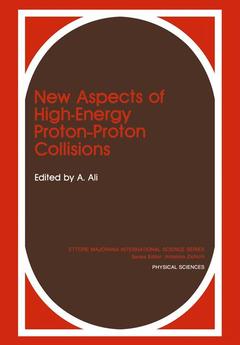Description
New Aspects of High-Energy Proton-Proton Collisions, 1988
Ettore Majorana International Science Series, Vol. 39
Language: English
Keywords
Boson; CERN; Cross section; Hadron; Lepton; Particle Physics; Quark; collision; particles; scattering
Publication date: 12-2012
434 p. · Paperback
434 p. · Paperback
Contents
/li>
1. The ELOISATRON Project: Eurasiatic Long Intersecting Storage Accelerator.- 1 Introduction.- 2 The Need for ELOISATRON.- 3 From Theory to Down-to-Earth Physics.- 4 The ELOISATRON Laboratory.- 5 Conceptual Design of the Full Scale ELOISATRON Project.- 6 Where the ELOISATRON Project has been Presented.- 7 Conclusions.- 2. Criteria for Steps to Higher Energies.- 1 Introduction.- 2 Physics Motivation.- 3 Machine Technology.- 4 Detector Technology.- 5 Financial Boundaries.- 6 Ecological, Sociological and Political Aspects.- 7 Concluding Remarks.- 3. The LEP Project at CERN.- 1 Introduction.- 2 The Status of LEP.- 3 The Detectors for LEP.- 4 Physics Goals.- 5 Evolution of the LEP Program.- 4. Physics at Future Colliders.- 5. Higgs Production in High Energy Hadron Collisions.- 1 Introduction.- 2 Scattering of Longitudinal Gauge Bosons.- 3 Higgs Search at LHC and SSC.- 4 Higgs Search at ELOISATRON.- 6. Supersymmetric Particle Searches at Future HadronColliders.- 1 Introduction.- 2 Supersymmetric Particles Signatures.- 3 Squarks and Gluinos.- 4 Electroweak Sparticles.- 5 Summary and Conclusions.- 7. Signatures of Compositeness in Very High Energy pp Collisions.- 1 Introduction.- 2 Contact Interactions.- 3 pp Collisions as a Source of Colored Composites.- 4 WLWL ? WLWL Scattering as Probe of the Higgs Sector.- 5 Conclusions.- 8. Leptoquarks at 100 TeV: Proton-Antiproton Collider.- 1 Introduction.- 2 Detection of Leptoquarks.- 3 QCD-Background.- 9. Physics of Superheavy Onia.- 1 Introduction.- 2 Heteroquark vs Homoquark.- 3 Upper Limits on the Quark Mass.- 4 Spectrum of Onia.- 5 Novel Features of Superheavy Onia.- 6 Annihilation Strength.- 7 Onia Production in Hadron Collisions.- 8 Decays of Superheavy Onia.- 9 Detection of Onia at Supercolliders.- 10 More Exotic States.- 11Onia Production at Higher Energies.- 12 Conclusions.- 10. New trigger System for High Luminosity Collisions.- 1 Introduction.- 2 Luminosity and Trigger Rates.- 3 Trigger Schemes.- 4 Conclusions.- 11. Particle Detectors Based on the New MultichannelPhotomultipliers.- 1 Basic Characteristics.- 2 Implementation of These Characteristics in a Detector.- 3 Special Characteristics of the Detector.- 12. Beauty Physics at the Ultrahigh Energies of the ELOISATRON.- 1 Introduction.- 2 Cross Sections.- 3 Production Angular Distributions of the Beauty Quarks.- 4 Momentum of the b Quarks and B Hadrons.- 5 Conclusion.- 13. Large Transverse Momentum Leptons in (Very) HighProton-(Anti)Proton Collisions.- 1 Introduction.- 2 Open Heavy Flavour Production.- 3 Comparison with UA1 Collider Data and Extrapolations to Higher Energies.- 4 Heavy Flavour Bound State Sources in Hadron-Hadron Interactions ..- 5 Comparison with Data and Extrapolations to Higher Beam Energies..- 14. Prompt Photons in Very High Energy Collisions.- 1 Introduction.- 2 QCD Predictions for Prompt Photon Cross Sections.- 3 Predictions for Collisions at TeV Energies.- 4 Production of Two Large-pT Photons.- 5 Background to New Physics.- 6 Conclusion.- 15. Drell-Yan Processes in High Energy Hadron Collisions.- 1 Introduction.- 2 Cross Sections and Luminosity Functions.- 3 W, Z Production at High Energies.- 4 New Gauge Boson Production.- 5 Conclusions.- 16. Proton-Proton and Antiproton-Proton Scattering at theHighest Energies.- 1 Introduction.- 2 The Glauber Model.- 3 The Cheng-Wu Impact Space Parametrisation.- 4 Crossing and High-Energy Behaviour of Amplitudes.- 5 Theorems of Asymptotic Behaviour.- 6 The Odderon Ansatz of Gauron, Nicolescu and Leader (GNL).- 7 Three-Gluon Exchange: The Model of Donnachie and Landshoff.- 8 Conclusion.- 17. Role of Multiple Parton Processes at Colliders.- 1 Introduction.- 2 Multiparton Scattering.- 3 Signatures of DDS.- 4 Shadowing of the Hard Total Cross Section.- 5 Concluding Remarks.- 18. Jet Physics-Theoretical Issues in Simulating Very HighEnergy Collisions.- 1 Introduction.- 2 Spin Correlations in Jets.- 3 Soft Gluon Coherence.- 4 Conclusions.- 19. Soft Processes in Very High Energy Proton-ProtonCollisions.- 1 Introduction.- 2 Hard and Soft Components in High-PT Jets.- 3 Minimum Bias Physics and Beam Jets.- 4 Pomeron Structure and Diffractive Scatterring.- 5 Conclusions.- 20. The Pattern of Lepton and Quark Masses.- 1 The Pattern of Lepton and Quark Masses.- 2 A Unique Parametrization of the Weak Mixing.- 3 Three Generations.- 4 Flavour Mixing for N-Generations.- 5 Conclusions.- 21. Non-Accelerator Physics at ?s ? 40 Te.- 1 Introduction.- 2 Proton Cross Section in Air.- 3 Realtion to ?pp.- 4 Extrapolation of Hadronic Interactions.- 5 Astrophysical Applications.- 22. Cosmic Accelerators: a New Era of Cosmic RayAstrophysics and Particle Physics.- 1 Cosmic Particles and their Detection.- 2 Cosmic Accelerators.- 3 Particle Physics with Cosmic Accelerators.- 4 Next-Generation Cosmic Ray Telescopes.- 5 Discussion.- Participants.
© 2024 LAVOISIER S.A.S.




